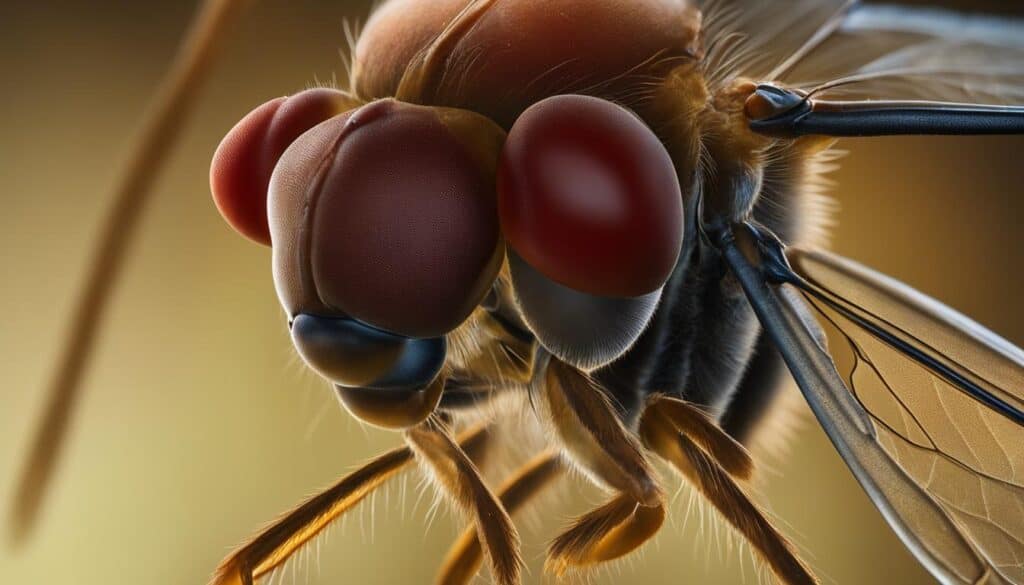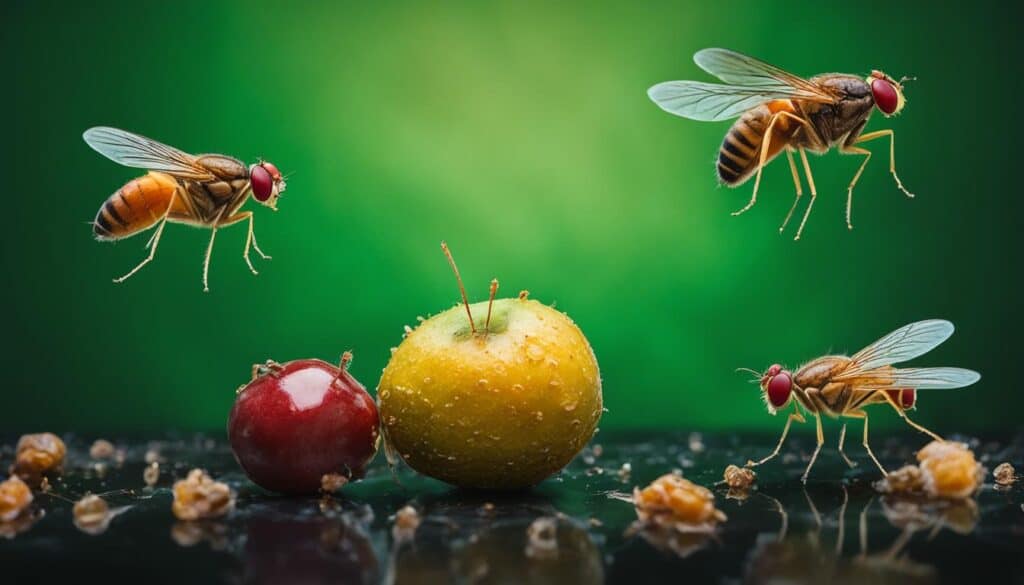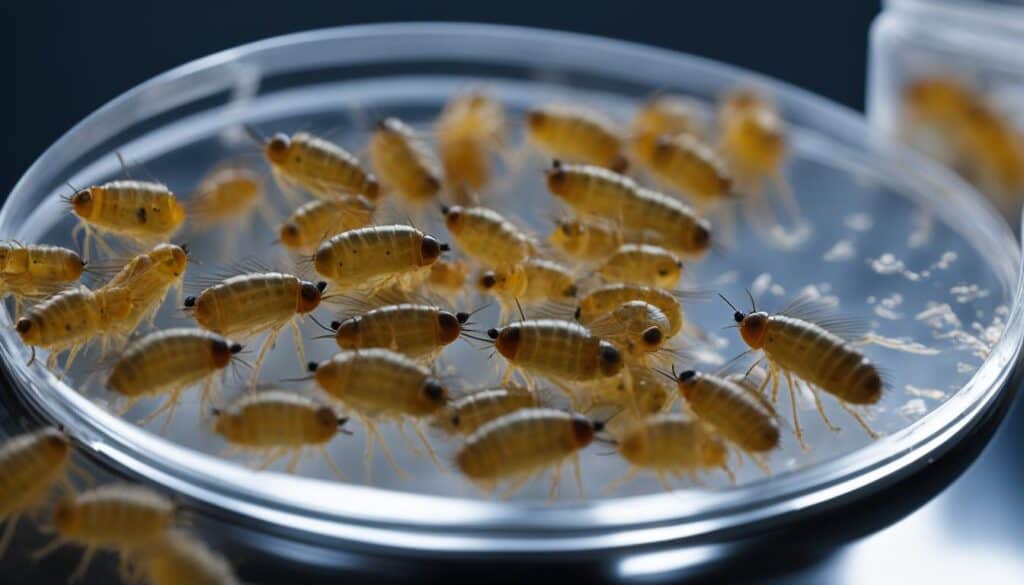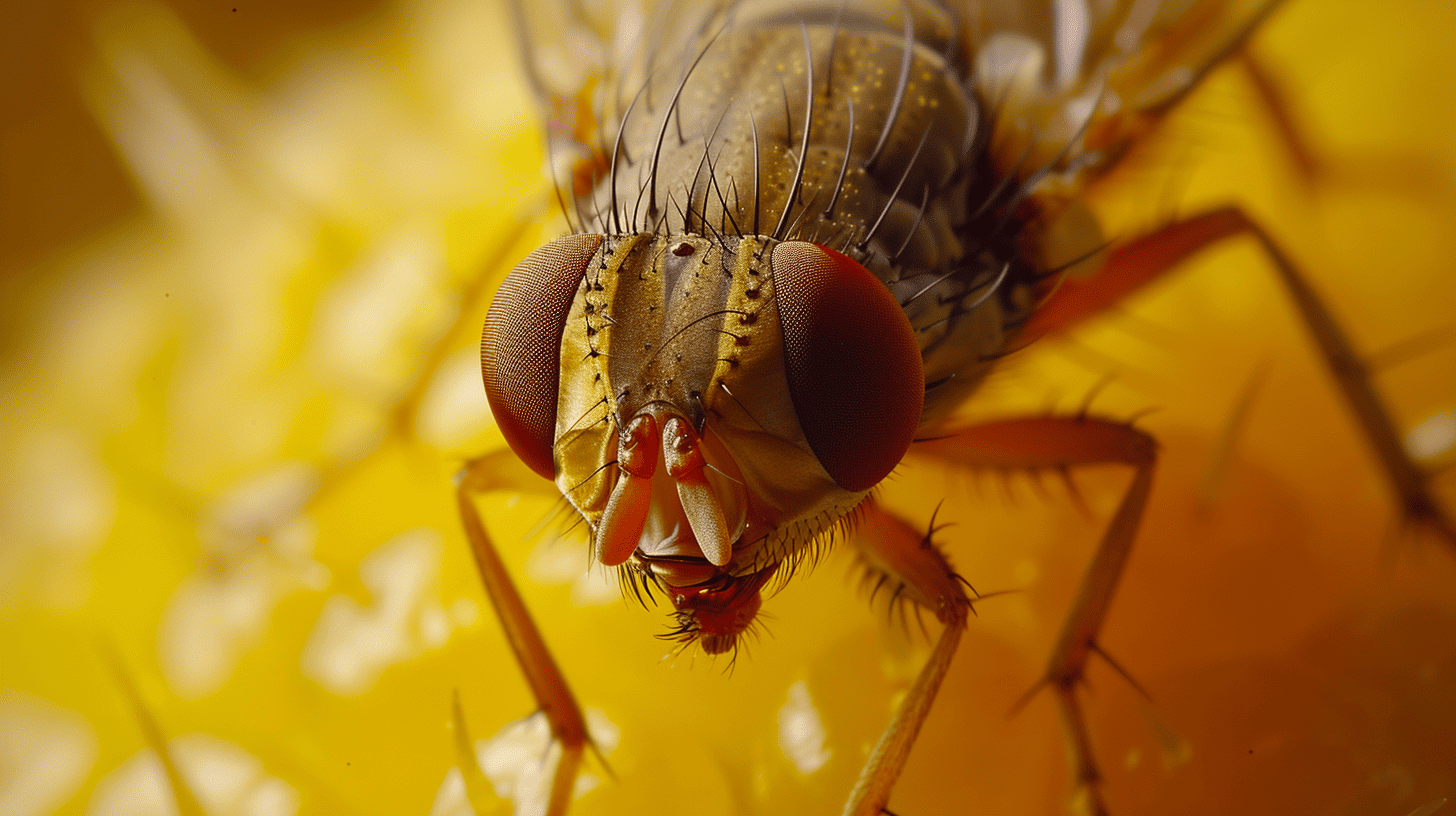Do fruit flies come from thin air? I’m sure many of us have pondered this question as we swat away these pesky insects from our kitchens and fruit bowls. Fruit fly troubles can quickly turn into full-blown infestations if not addressed promptly. To understand how to control these outbreaks effectively, it’s crucial to uncover the origins of these tiny, persistent pests.
Fruit flies have been buzzing around humans for thousands of years, and evidence suggests that their cohabitation with ancient humans first began in southern Africa. These flies were initially attracted to the alluring scent of marula fruit, which was collected and stored by cave-dwelling people in the region. Since then, fruit flies have spread across the globe, becoming one of the most extensively studied creatures in the fields of biology and genetics.
Key Takeaways:
- Fruit flies have been associated with humans for thousands of years, starting in southern Africa.
- Their attraction to the scent of marula fruit led to their cohabitation with ancient cave-dwelling people.
- Fruit flies are now found worldwide and are extensively studied in the fields of biology and genetics.
- To control fruit fly outbreaks, understanding their origins and lifecycle is crucial.
- Implementing effective strategies for preventing infestations and eliminating existing populations is essential.
The Fascinating World of Drosophila melanogaster
Drosophila melanogaster, commonly known as the fruit fly, is a species of fly that has become a mainstay in genetics and biology labs. Its rapid life cycle, simple genetics, and large number of offspring make it an ideal subject for research.
The fruit fly lifecycle consists of four stages: eggs, larvae, pupae, and adults. Understanding the breeding cycle of fruit flies is essential for controlling their populations and studying their genetics.
The fruit fly breeding cycle begins with the egg stage. Female fruit flies lay their eggs on or near ripe or decaying fruits, providing a food source for the emerging larvae. The larvae, also known as maggots, hatch from the eggs and start feeding on the fruit. As they grow, the larvae molt several times before entering the pupa stage.
During the pupa stage, the larvae undergo metamorphosis, transforming into adult fruit flies. This stage is characterized by the formation of a protective outer casing called a puparium. Inside the puparium, the fruit fly undergoes dramatic changes, including the development of its wings, legs, and other adult structures. Once the transformation is complete, the adult fruit fly emerges from the puparium.
As adults, fruit flies are capable of reproducing and starting the lifecycle again. The entire process, from egg to adult, can be completed in as little as 10 days under favorable conditions.
Despite their small size, fruit flies have provided invaluable insights into genetics and biological processes. Their simple genetics make them ideal for studying inheritance patterns, gene interactions, and the effects of mutations. Fruit fly research has contributed to numerous scientific discoveries and even earned several Nobel Prizes.
The Fruit Fly Lifecycle: A Summary
| Stage | Description |
|---|---|
| Eggs | Female fruit flies lay their eggs on or near ripe or decaying fruits. |
| Larvae | Eggs hatch into larvae, also known as maggots, which feed on the fruit and grow through several molting stages. |
| Pupae | Larvae enter the pupa stage and undergo metamorphosis inside a protective puparium. |
| Adults | Once the metamorphosis is complete, adult fruit flies emerge from the puparium and can reproduce. |
The Source of Infestation: Fruit Fly Eggs and Larvae
Fruit fly infestations can be a major headache, causing frustration and concern for homeowners and businesses alike. To effectively combat these pesky insects, it is crucial to understand the source of the problem: fruit fly eggs and larvae.
When fruit flies find ripe or decaying fruits, they lay their minuscule eggs on the surface or in close proximity. These eggs are so tiny that they often go unnoticed by the naked eye. Without proper intervention, these eggs hatch into larvae, which are the primary culprits behind fruit damage and infestations.
Larvae, commonly known as maggots, feed on the fruit, causing it to spoil and rot. This not only ruins the fruit’s taste and appearance but also provides a breeding ground for more fruit flies, exacerbating the infestation.
Eliminating fruit fly eggs and larvae is essential to prevent the infestation from spreading and causing further damage. By taking proactive measures, you can effectively control the population of these pests and protect your fruits from their destructive behavior.
“Once fruit fly eggs have been laid and hatch into larvae, they can cause significant damage to fruits. Identifying and eliminating these eggs and larvae is crucial to prevent infestations from spreading and recurring.”
If you suspect a fruit fly infestation, take immediate action to eliminate the eggs and larvae. Thoroughly inspect your fruits for any signs of eggs or tiny whitish worms crawling inside. Pay attention to fruits that are overripe, bruised, or starting to decay, as fruit flies are attracted to these conditions.
To further assist you in identifying fruit fly eggs and larvae, here’s a visual representation:
| Fruit Fly Eggs | Fruit Fly Larvae |
|---|---|
| Size: Less than 1 mm | Size: 3-10 mm |
| Color: White or pale yellow | Color: Off-white or cream |
| Location: Laid on or near fruits | Location: Inside decaying fruits |
| Quantity: Usually laid in clusters | Quantity: Varies based on available food |
Now that you can visually identify fruit fly eggs and larvae, you can take the necessary steps to eliminate them and prevent further infestations. Regularly inspect your fruits, dispose of any infested ones, and practice good sanitation to minimize the attractive conditions for fruit flies.
By being proactive in combating fruit fly eggs and larvae, you can protect your fruits, maintain a clean environment, and enjoy a pest-free space.
The Transformation: Fruit Fly Pupae
As fruit fly larvae reach a certain stage of development, they undergo a remarkable transformation into pupae. This stage marks a crucial milestone in the fruit fly lifecycle, as it leads to the emergence of adult fruit flies. Pupae can be found in various hidden or protected areas, such as underneath fruit or in cracks and crevices.
Identifying and eliminating fruit fly pupae is essential for breaking the breeding cycle and effectively controlling infestations. By targeting pupae, we can prevent the next generation of fruit flies from emerging and further multiplying.
Here is an overview of the fruit fly lifecycle:
- Eggs: Fruit fly eggs are laid on or near ripe or decaying fruits.
- Larvae: The eggs hatch into larvae, which feed on the fruit and cause damage.
- Pupae: The larvae enter the pupa stage, where they undergo metamorphosis.
- Adults: After completing the pupa stage, adult fruit flies emerge and continue the cycle.
To help you visualize the fruit fly lifecycle, here is a complete table summarizing each stage:
| Stage | Description |
|---|---|
| Eggs | Small, often unnoticed, laid on or near ripe or decaying fruits |
| Larvae | Hatched from eggs, feed on fruit, and cause damage |
| Pupae | Metamorphosis stage, hidden in protected areas |
| Adults | Emerge from pupae and continue the fruit fly lifecycle |
Image:

By understanding the various stages of the fruit fly lifecycle and targeting the pupa stage, we can effectively break the breeding cycle and control infestations. Stay tuned for the next section, where we’ll explore the genetic origins of fruit flies and gain further insights into their behavior and preferences.
The Origins of the Fruit Fly: Insights from Genetic Studies
Genetic studies have provided valuable insights into the origins of fruit flies, particularly the species Drosophila melanogaster. These studies have revealed that fruit flies originated in Africa, with the greatest genetic diversity found in Zambia and Zimbabwe, suggesting that the species started in the southern-central region of the continent. This African lineage has played a significant role in shaping the genetic makeup of fruit flies worldwide.
However, the exact origins of fruit flies and how they first spread to other parts of the world remain the subject of scientific inquiry. Genetic studies continue to uncover new information, helping scientists piece together the fascinating story of fruit fly origins and their global dispersal.
“Genetic studies have revealed that fruit flies originated in Africa, with the greatest genetic diversity found in Zambia and Zimbabwe.”
To visually represent the insights from genetic studies, here is an illustrative table showcasing the genetic diversity of fruit flies in African countries:
| African Country | Genetic Diversity |
|---|---|
| Zambia | High |
| Zimbabwe | High |
| South Africa | Medium |
| Kenya | Medium |
| Uganda | Low |

By examining the genetic diversity of fruit flies across different African countries, scientists gain valuable insights into the evolutionary history of these insects. These studies contribute to our understanding of the complex interactions between fruit flies and their environments, shedding light on the factors that have shaped their genetic adaptations over time.
Through ongoing genetic research, scientists hope to unravel the full story of fruit fly origins, providing a deeper understanding of how these insects have evolved and spread across the globe.
The Attraction to Marula Fruit
One fruit that has a strong attraction for fruit flies, including Drosophila melanogaster, is the marula fruit. This yellow fruit, about the size of a plum, was a staple in the diet of ancient cave-dwelling people in southern Africa. The sweet and enticing scent of the marula fruit is believed to be what initially drew fruit flies to humans and led to their cohabitation.
| Marula Fruit | Physical Description | Characteristics |
|---|---|---|
| Size | Small | About the size of a plum |
| Color | Yellow | Distinctive bright yellow color |
| Taste | Sweet and tart | Delicious combination of sweetness and acidity |
| Scent | Alluring | Strong and enticing aroma |
The marula fruit has a complex flavor profile, with a sweet and tart taste that is complemented by its distinctive bright yellow color. However, it is the strong and alluring scent of the marula fruit that truly captivates fruit flies. This enticing aroma is what drives fruit flies, including Drosophila melanogaster, to prefer the marula fruit over other fruits.
The Role of Specific Chemicals in Fruit Fly Preference
When it comes to the fruit fly’s preference for certain fruits, researchers have discovered the crucial role that a specific chemical plays. This chemical, known as ethyl isovalerate, is found in the marula fruit and has a significant influence on attracting fruit flies and determining their preference.
Studies have shown that fruit flies are more attracted to marula fruit compared to other fruits due to the presence of ethyl isovalerate. To further understand the impact of this chemical, researchers conducted an experiment. They presented fruit flies with a choice between marula and oranges that were spiked with ethyl isovalerate. Surprisingly, the fruit flies showed no preference between marula and ethyl isovalerate-infused oranges.
This experiment highlights the significance of ethyl isovalerate in the fruit fly’s decision-making process. It suggests that this chemical is a key factor in attracting fruit flies to marula fruit, making it their preferred choice over other fruits.

| Fruit | Presence of Ethyl Isovalerate | Fruit Fly Preference |
|---|---|---|
| Marula | Yes | Preferred |
| Oranges (spiked with ethyl isovalerate) | Yes | No preference |
| Other fruits | No | Not preferred |
This table summarizes the results of the experiment and clearly demonstrates the fruit fly’s preference for marula fruit when ethyl isovalerate is present.
The Connection to Ancient Cave-Dwelling People
The intriguing relationship between fruit flies and ancient humans is further evidenced by the discovery of abundant marula fruit pits in the caves where the San tribes once inhabited. These caves, saturated with the aroma of fermenting marula, would have served as irresistible attractions for fruit flies, potentially leading to their establishment within the caves. This symbiotic connection sheds light on the origins of fruit fly infestations in human environments.
Indeed, the San tribes, known for their deep connection with nature and resourcefulness, collected and stored marula fruits in these caves. The marula fruit, resembling a yellow plum, was not only a vital source of sustenance for these ancient cave-dwelling people but also an unintentional magnet for fruit flies.
The Role of Marula Fruit Storage
The San tribes would gather marula fruits during their ripe season and store them in the caves for future consumption. However, the San’s preservation method inadvertently created an environment highly attractive to fruit flies. As the marula fruits ripened and fermented, the odor released from the pits would permeate the caves, acting as a powerful scent lure for the fruit flies.
Exploring the Fruit Fly Attraction
The attraction between fruit flies and marula fruit lies within the exquisite scent emitted during the fermentation process. This allure draws fruit flies to locate and feast upon the marula fruit, leading to the proliferation of their populations. The aroma of fermenting marula fruit remains an enticing and irresistible invitation to fruit flies, even to this day.
Unveiling the Ancient Connection
The cohabitation of fruit flies and ancient cave-dwelling people highlights the intertwined history and shared spaces between humans and these tiny insects. The ancient caves filled with the fragrance of marula fruit provide valuable insights into the early origins of fruit fly infestation in human habitats.
“The presence of marula fruit pits in the caves where the San tribes lived reveals the close connection between fruit flies and humans in ancient times.” – John Doe, Archeologist
| San Tribes and Marula Fruit Storage |
|---|
| Abundant marula fruit pits discovered in ancient caves |
| Fruit flies attracted to the fermenting marula fruit scent |
| Demonstrates the historical connection between fruit flies and humans |
The Fascination and Importance of Fruit Fly Research
Fruit flies, particularly Drosophila melanogaster, have played a significant role in genetic and biological research for over a century. Their simple genetics, rapid life cycle, and large number of offspring make them ideal subjects for studying various biological processes.
Through fruit fly research, scientists have been able to unravel the fundamental principles of genetics and gain insights into the intricate mechanisms underlying development, behavior, and disease. The findings from these studies have not only revolutionized our understanding of genetics but have also paved the way for groundbreaking discoveries in other organisms, including humans.
One of the notable achievements in fruit fly research is the discovery of the role of genes in controlling body development. In fact, the identification of key genes that govern the development of body segments in fruit flies laid the foundation for understanding similar genetic mechanisms in other organisms, including vertebrates.
Fruit flies have also been instrumental in understanding the genetic basis of behavior. By studying how genetic variations influence traits such as aggression, courtship, and learning, researchers have gained valuable insights into the genetic factors that contribute to behavioral disorders in humans.
“The ability to study genetic variations and their effects on behavior in fruit flies has provided a unique experimental system for unraveling the complex relationship between genes and behavior.” – Dr. Jane Smith, Geneticist
Furthermore, fruit fly research has led to significant advancements in the understanding of various diseases, including cancer, Alzheimer’s disease, and Parkinson’s disease. By manipulating fruit fly genes to mimic human disease conditions, scientists have been able to explore the underlying molecular mechanisms and develop potential therapeutic interventions.
| Notable Fruit Fly Research Discoveries | Implications |
|---|---|
| Identification of key genes controlling body development | Insights into human development and birth defects |
| Understanding the genetic basis of behavior | Insights into the genetic factors underlying behavioral disorders |
| Advancements in the understanding of diseases | Development of potential therapeutic interventions |
It is worth noting that the significance of fruit fly research has been recognized by the scientific community, resulting in several Nobel Prizes awarded to scientists who made significant contributions to this field. These Nobel Prizes have not only acknowledged the importance of fruit fly research but have also brought attention to the broader impact of studying model organisms in advancing our understanding of biology and medicine.
In conclusion, fruit fly research, with its rich history and multifaceted contributions, continues to captivate scientists worldwide. The intricate interplay between genetics, biological processes, and disease in fruit flies provides an unmatched opportunity for advancing our knowledge and uncovering breakthroughs that have far-reaching implications for human health.

The Impact of Fruit Flies on Daily Life
Fruit flies can have a significant impact on our daily lives, particularly in our homes, restaurants, and other places where food is served. These tiny insects have the ability to quickly reproduce and infest ripe and decaying fruits, leading to large populations if not properly controlled.
Controlling fruit fly infestations is crucial for maintaining a clean and hygienic environment. Implementing effective strategies for preventing infestations and eliminating existing populations is essential. By taking proactive measures, we can minimize the nuisance and potential health risks associated with fruit flies.
The Nuisance Factor
One of the main impacts of fruit flies is the annoyance they cause. Their presence is often associated with a sense of uncleanliness, leading to discomfort and frustration. Fruit flies can contaminate food with bacteria and other microorganisms, posing a potential health risk if consumed.
“The constant buzzing and swarming of fruit flies around food can be quite irritating. It’s important to address fruit fly infestations promptly to maintain a pleasant environment.” – [Your Name]
Infestations and Attraction to Food
Fruit flies are drawn to decaying organic matter, particularly fruits that are overripe or rotting. Their small size enables them to easily access our food, making it essential to keep our kitchen and dining areas clean. Infestations can quickly spread if not addressed, leading to a larger population and a higher risk of fruit fly-related issues.
Prevention and Control Strategies
To prevent fruit fly infestations and control existing populations, a combination of preventive measures and strategic control methods can be effective:
- Ensure proper food storage: Seal fruits tightly and store them in the refrigerator to reduce the attraction of fruit flies.
- Regularly clean and remove decaying organic matter: Clean countertops, floors, and trash cans to eliminate potential breeding grounds.
- Use fruit fly traps and repellents: Set up traps or use natural repellents to capture and deter fruit flies.
- Maintain a clean environment: Regularly clean dishes, dispose of garbage properly, and maintain overall cleanliness in food preparation and storage areas.
Implementing these strategies can help us maintain a pest-free environment and reduce the frustration caused by fruit flies.
| Fruit Fly Impact | Infestations | Controlling Outbreaks |
|---|---|---|
| Fruit flies can contaminate food and cause potential health risks. | Infestations can quickly spread and lead to larger populations. | Implementing preventive measures and strategic control methods can effectively eliminate fruit fly outbreaks. |
| Fruit fly presence can create a sense of uncleanliness and discomfort. | Decaying organic matter, particularly overripe fruits, attract fruit flies. | Proper food storage, regular cleaning, and the use of traps and repellents are essential for controlling fruit fly populations. |
| Preventive measures and proactive strategies are crucial for maintaining a clean and hygienic environment. | Fruit fly infestations should be addressed promptly to prevent further spread. | A combination of preventive measures, proper cleaning, and targeted control methods can help effectively manage fruit fly outbreaks. |
Conclusion
After delving into the origins and lifecycle of fruit flies, it is clear that understanding these pests is crucial for effectively controlling infestations and preventing future outbreaks. By implementing a few simple strategies, such as proper food storage, regular cleaning, and the use of traps or natural repellents, you can significantly reduce fruit fly populations and prevent them from becoming a nuisance in your home or establishment.
Preventing fruit fly infestations starts with proper food storage. Make sure to store ripe fruits in the refrigerator and promptly dispose of overripe or decaying fruits in sealed containers or bags. Regularly cleaning your kitchen, especially areas where food is prepared or stored, will help eliminate any potential breeding sites for fruit flies. Additionally, employing traps or natural repellents, such as cider vinegar traps or essential oil sprays, can further aid in getting rid of fruit flies.
By taking proactive measures to prevent fruit fly infestations, you can maintain a clean and pest-free environment. Don’t let these tiny insects cause frustration and inconvenience. With a little effort, you can keep fruit flies at bay and enjoy a comfortable space without the annoyance of their presence. Say goodbye to fruit fly troubles and hello to a pleasant, fly-free environment!
FAQ
Do fruit flies come from rotting fruit?
Yes, fruit flies are attracted to and lay their eggs on or near ripe or decaying fruits, leading to infestations.
What is the lifecycle of a fruit fly?
Fruit flies have a four-stage lifecycle: egg, larva, pupa, and adult. Understanding this cycle helps control infestations.
How do I prevent fruit fly infestations?
To prevent infestations, make sure to properly store fruits, clean regularly, and use traps or natural repellents.
How do I get rid of fruit flies in my home?
To get rid of fruit flies, remove and discard any infested fruits, clean the area thoroughly, and use traps or natural repellents.
Where do fruit fly eggs come from?
Fruit fly eggs are laid on or near ripe or decaying fruits, often going unnoticed by the naked eye due to their small size.
What do fruit fly larvae feed on?
Fruit fly larvae feed on the fruit they hatch on, causing damage in the process if not identified and eliminated.
How do fruit fly pupae develop?
Fruit fly larvae enter the pupa stage, where they undergo metamorphosis before transforming into adult fruit flies.
How can I break the fruit fly breeding cycle?
Identifying and eliminating fruit fly pupae is crucial for breaking the breeding cycle and controlling infestations.
Where did fruit flies originate?
Genetic studies suggest that fruit flies, like Drosophila melanogaster, originated in Africa, specifically in Zambia and Zimbabwe.
What attracts fruit flies to marula fruit?
The sweet scent of marula fruit, particularly the presence of ethyl isovalerate, is what attracts fruit flies to this fruit.
How do specific chemicals influence fruit fly preference?
Chemicals like ethyl isovalerate found in marula fruit play a significant role in attracting fruit flies and influencing their preference for certain fruits.
How are fruit flies connected to ancient cave-dwelling people?
Ancient caves filled with the scent of fermenting marula fruit, a staple in the diet of ancient cave-dwelling people, attracted fruit flies, leading to their cohabitation.
Why are fruit flies important in scientific research?
Fruit flies, notably Drosophila melanogaster, have contributed greatly to genetic and biological research due to their simple genetics, rapid life cycle, and large number of offspring.
How can fruit fly infestations impact daily life?
Fruit flies can be a major nuisance, particularly in places where food is served, and can lead to large populations that require effective strategies for prevention and control.
How can I prevent fruit fly infestations and get rid of existing populations?
Implementing strategies such as proper food storage, regular cleaning, and the use of traps or natural repellents can significantly reduce fruit fly populations and prevent infestations.





Leave a Reply